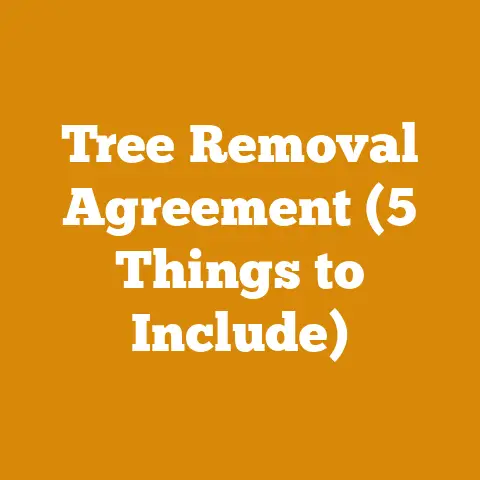Tree Fertilizer (4 Best Options for Growth)
If you’re like me and love trees, you know they need a little extra help sometimes.
Fertilizing can be a game-changer for tree growth, but only if you pick the right one.
Let’s dive into the best options for boosting your tree’s health.
The Urgency of Tree Care
Have you noticed your trees looking a bit lackluster?
Nutrient deficiencies might be the culprit.
The right fertilizer can revitalize them, promoting strong growth and resilience.
I remember a time when my favorite oak tree began to lose its vibrancy.
It was heartbreaking to watch, but with the right care and nutrients, it transformed back into the majestic tree I cherished.
Why Fertilize?
Fertilizing trees isn’t just about making them look good.
It’s about ensuring they have the strength to withstand environmental stresses, diseases, and pests.
Neglecting this can lead to weakened structures that are more susceptible to damage.
Picture this: a healthy tree is like a well-fed athlete, ready to take on challenges with vigor.
The Science Behind Fertilization
Trees require a balanced intake of nitrogen, phosphorus, and potassium—each serving a unique function.
Nitrogen fuels leafy growth, phosphorus supports root development, and potassium enhances overall resilience.
Understanding these nutrients helps tailor our approach to specific tree needs.
4 Best Fertilizer Options for Tree Growth
1. Slow-Release Fertilizers
These are my personal favorite!
Slow-release fertilizers provide nutrients over time, which means less work for you.
How It Works
The nutrients are coated in a material that dissolves slowly, feeding your tree gradually.
This mimics nature’s way of providing nutrients, akin to a drip-feed system.
Application Steps
- Evaluate Soil Needs
Test your soil to know what nutrients are lacking.
Back when I started gardening, I missed this step and ended up over-fertilizing, which stunted growth rather than promoting it. - Choose the Right Formula
Look for a balanced mix like 10-10-10 or 14-14-14.
I once experimented with different ratios and found that my maple trees thrived best with slightly higher nitrogen content. - Apply Around Drip Line
Spread evenly under the canopy, not directly at the trunk.
This prevents root burn and ensures even distribution. - Water Thoroughly
Helps dissolve and distribute nutrients. Watering also stabilizes the soil, preventing erosion.
Safety Precautions
- Wear Gloves
Protects your hands from chemicals. - Avoid Over-fertilizing
Too much can harm your tree and the environment.
I learned this the hard way when my spruce turned yellow due to excessive nutrients.
Tips & Warnings
- Tip: Use in spring or early fall for best results.
- Warning: Do not use on newly planted trees; it may burn roots.
2. Liquid Fertilizers
Liquid fertilizers are great for quick absorption.
I use them when trees need an urgent nutrient boost.
How It Works
These fertilizers are diluted in water, allowing for direct uptake by tree roots.
This method is analogous to giving your tree a vitamin shot.
Application Steps
- Mix with Water
Follow label instructions for correct dilution.
A friend once ignored this advice and ended up with burnt leaves due to too strong a mixture. - Apply to Soil
Water the base of the tree thoroughly. - Repeat as Needed
Usually every 4-6 weeks during growing season.
Consistency is key here, much like maintaining a balanced diet for yourself.
Safety Precautions
- Read Labels Carefully
Some formulas can be too strong if improperly mixed.
Tips & Warnings
- Tip: Best for young trees needing rapid growth.
- Warning: Can leach away quickly in sandy soils, requiring more frequent applications.
3. Organic Fertilizers
If you’re into sustainable gardening, organic fertilizers are your go-to.
They improve soil health naturally.
How It Works
Made from natural materials like manure or bone meal, these release nutrients slowly as they break down.
Application Steps
- Choose Organic Type
Options include compost, composted manure, or bone meal. - Spread Evenly
Apply around the drip line, incorporating into the topsoil lightly. - Water In
Ensures good contact with soil and begins nutrient release.
Safety Precautions
- Use A Mask
Protects from inhaling dust during application.
Tips & Warnings
- Tip: Great for improving soil structure over time.
- Warning: May attract pests if not properly composted before use.
4. Spike Fertilizers
Convenient and easy to use, spikes are pre-measured, reducing guesswork.
How It Works
Spikes are driven into the ground, releasing nutrients as they dissolve with rain or watering.
Application Steps
- Determine Number Needed
Based on tree size—check packaging for guidelines. - Drive Spikes Into Ground
Place around the drip line using a mallet if necessary. - Space Evenly
Allows for uniform nutrient distribution.
Safety Precautions
- Wear Protective Eyewear
Prevents injury from flying debris when hammering spikes in.
Tips & Warnings
- Tip: Ideal for busy gardeners who want a no-mess solution.
- Warning: Limited to surface root zones; not ideal for large trees.
Equipment & Knowledge Prerequisites
Required Materials
- Soil test kit
- Appropriate fertilizer choice
- Watering can or hose
- Gloves and protective eyewear
- Mallet (for spikes)
Prerequisite Knowledge
Understanding of your tree species and its specific nutrient needs is crucial.
Conducting a soil test will guide your fertilizer selection process effectively.
Common Questions & Concerns
Q: How often should I fertilize my trees?
A: Generally, once in spring and possibly again in fall, depending on tree health and soil conditions.
Q: Can over-fertilizing harm my trees?
A: Yes, it can cause root burn and environmental damage. Always follow recommended amounts.
Q: What’s the best time to apply fertilizer?
A: Early morning or late afternoon to prevent evaporation and ensure absorption.
Troubleshooting Tips & Best Practices
If you notice yellowing leaves or stunted growth despite fertilizing, check for:
- Incorrect fertilizer type
- Poor watering habits
- Pest issues
- Soil compaction
Best Practice Advice
Always start with a soil test to tailor your approach to your tree’s specific needs.
Monitor changes post-fertilization to adjust future practices accordingly.
Important Reminders & Next Steps
Remember, healthy trees start with healthy soil!
Keep testing your soil and observing your trees’ response to fertilization efforts.
Adjust as needed and enjoy watching your trees thrive!
FAQ Section
Q: Can I use lawn fertilizer on my trees?
A: Not recommended; lawn fertilizers can be too high in nitrogen, leading to excessive foliage growth at the expense of root development.
Q: Are there natural alternatives to commercial fertilizers?
A: Yes, options include compost, wood ash, and seaweed extracts, all of which enrich soil naturally without chemicals.
Q: What if my tree doesn’t show improvement after fertilizing?
A: Re-evaluate your choice of fertilizer, application method, and consider consulting an arborist for persistent issues.






